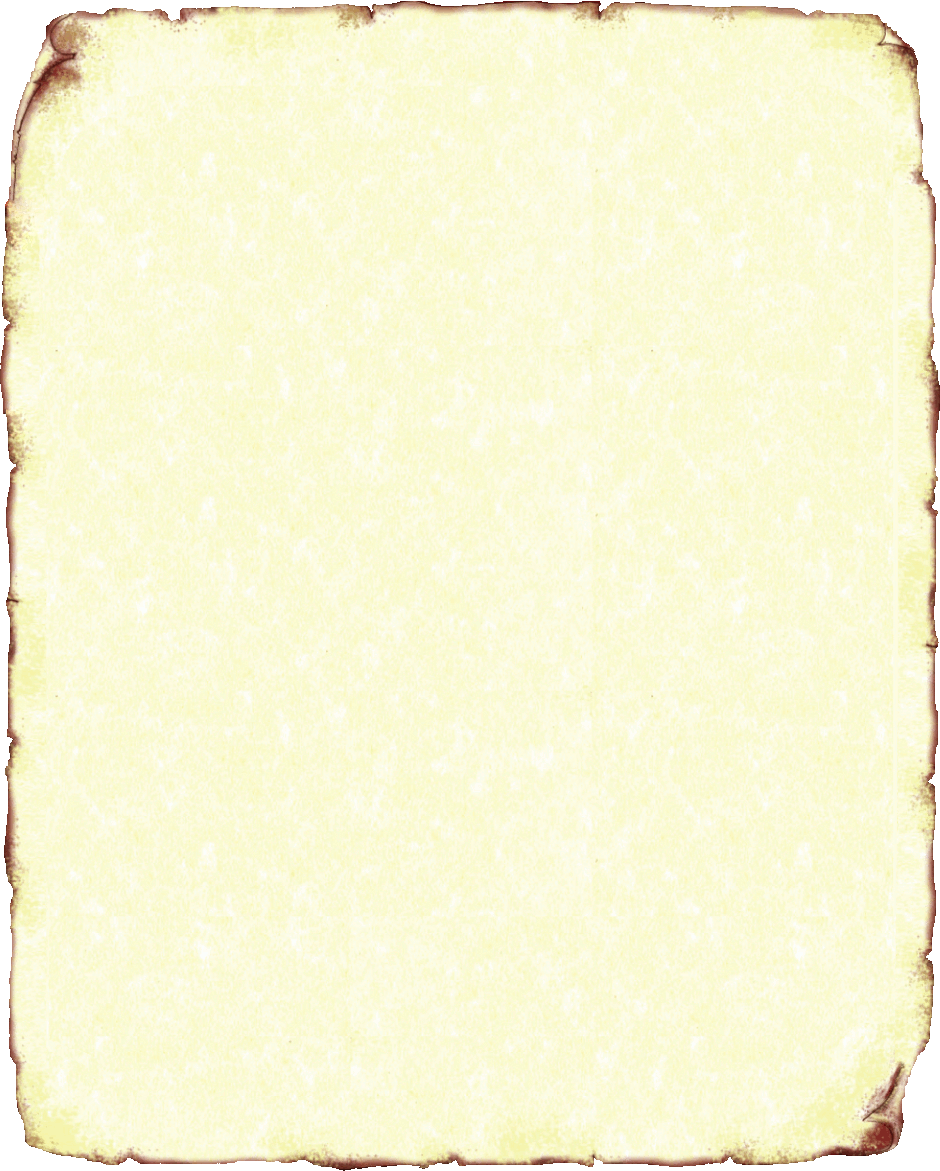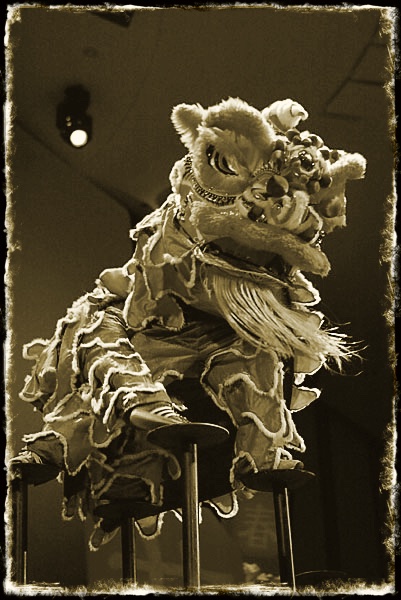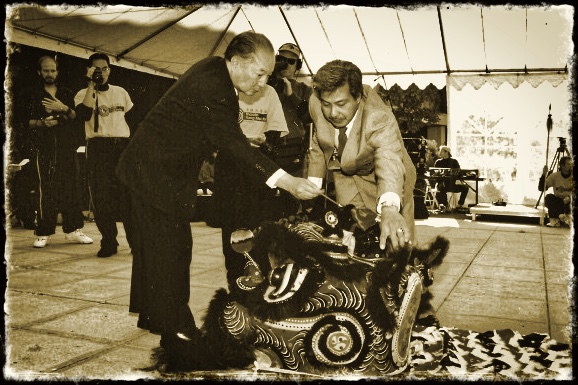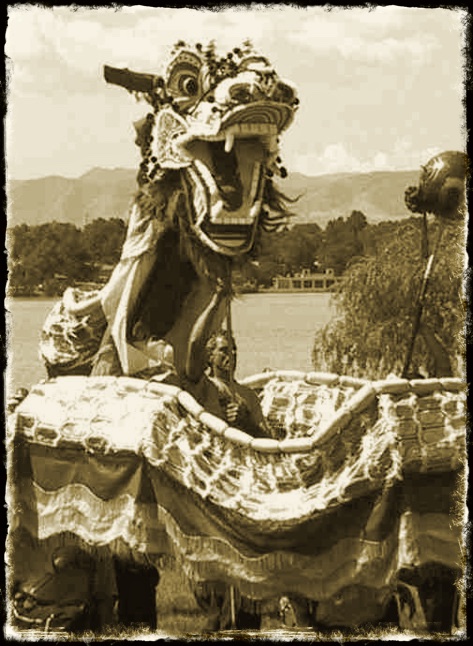
Martial Study
Lion & Dragon Performance Training
Lion Dancing
History of the Lion Dance
 The legend behind the Southern Lion teaches us that many generations ago, a peculiar animal appeared in the Guăn Dōng (廣東) province of China on the eve of Chinese New Year. Since the New Year is a time for celebration, the residents did not want to be troubled by this strange animal. At some point, they decided to construct facsimiles of the animal with which to chase it away. The heads were made by painting paper covered bamboo frames and the bodies by sewing triangles of cloth together. During the next New Year, two man teams together with drum, gong and cymbal players, roamed the province and scared what had been called the "nián shòu" (年獸) or Annual Beast away, never to return. The legend has grown to mean that the performance of the Lion chases away evil spirits and welcomes good luck and good fortune.
The legend behind the Southern Lion teaches us that many generations ago, a peculiar animal appeared in the Guăn Dōng (廣東) province of China on the eve of Chinese New Year. Since the New Year is a time for celebration, the residents did not want to be troubled by this strange animal. At some point, they decided to construct facsimiles of the animal with which to chase it away. The heads were made by painting paper covered bamboo frames and the bodies by sewing triangles of cloth together. During the next New Year, two man teams together with drum, gong and cymbal players, roamed the province and scared what had been called the "nián shòu" (年獸) or Annual Beast away, never to return. The legend has grown to mean that the performance of the Lion chases away evil spirits and welcomes good luck and good fortune.
There are many variations of Lion Dances. Typically, the highlight of the performance is the Lion “picking the greens,” most often a head of lettuce. The picking of the greens meant that there would be a good harvest. Over the passage of time, the picking of the greens became symbolic for prosperity.
The skill presented in the performance of the Lion Dance is a direct indication of the level of skill of the practitioners' Kung Fu. Within the structure of the performance, the students learn and strengthen their stances, improve coordination and enhance both their cardiovascular and strength conditioning. In order to test the performers' skill, the lettuce is often placed in difficult-to-reach places. The student performing the Lion head may have to be lifted high into the air or grab the lettuce from some relatively inaccessible place.
A gift or donation usually accompanies the lettuce. Traditionally, the gift is placed in a red envelope, "hóng bāo" (紅包). It is an expression of gratitude for having the Lion Dance, wishing luck, health and prosperity to all those watching the performance.
Explanation of the Eye Dotting Ceremony
 The "Eye Dotting Ceremony" is a ritual by which a new "Lion" is awakened. The Lion cannot be used in a performance until the ceremony is complete and the spirit of the Lion has been given "life." During the ceremony, an individual is selected to dot the Lion with symbolic blood (traditionally, pigeon blood was used - today, we use red ink). First the forehead is dotted to give the Lion life. Second are the eyes for sight, followed by the nose, tongue, ears, horn, back of head, spine and, finally, tail. After the Eye Dotting Ceremony, a Lion Dance is performed.
The "Eye Dotting Ceremony" is a ritual by which a new "Lion" is awakened. The Lion cannot be used in a performance until the ceremony is complete and the spirit of the Lion has been given "life." During the ceremony, an individual is selected to dot the Lion with symbolic blood (traditionally, pigeon blood was used - today, we use red ink). First the forehead is dotted to give the Lion life. Second are the eyes for sight, followed by the nose, tongue, ears, horn, back of head, spine and, finally, tail. After the Eye Dotting Ceremony, a Lion Dance is performed.
Myth of the Dragon
 In the Chinese hierarchy of animals, the Dragon reigns supreme. They believe that the Dragon is a mystical and godly creature and hold it in a position of deep respect and fear. The Dragon is considered to be an auspicious object possessing the sole power of bringing the winds and the rain. At the same time, it is a destructive force since it can bring on storms and typhoons. The Dragon’s strength is unrivalled by any other beast, even by those of great ferocity. It is for that reason that the fisherman anointed the Dragon as controlling head of the seas, built temples to worship it and asked for its blessings to keep the waters and winds calm.
In the Chinese hierarchy of animals, the Dragon reigns supreme. They believe that the Dragon is a mystical and godly creature and hold it in a position of deep respect and fear. The Dragon is considered to be an auspicious object possessing the sole power of bringing the winds and the rain. At the same time, it is a destructive force since it can bring on storms and typhoons. The Dragon’s strength is unrivalled by any other beast, even by those of great ferocity. It is for that reason that the fisherman anointed the Dragon as controlling head of the seas, built temples to worship it and asked for its blessings to keep the waters and winds calm.
